
Man Ray at The Jewish Museum
— by Gordon Fitch
Presently on view and open until March 13,
The Jewish Museum is putting on a relatively
large exhibition of Man Ray's work titled
"Alias Man Ray".
As anyone who has read his charming "autobiography"
Self Portrait knows, Man Ray went out
of his way to obfuscate and mystify his background,
not only as a Jew and child of working-class
immigrants, but even as an American. Even towards
the end of his life, to a niece due to be
interviewed, he said, "Don't tell them
anything!"
To some extent this must have simply been
business. There was plenty of xenophobia and
anti-Semitism to go around in the America of 100
years ago when Man Ray was growing up and trying
to get out in the world, to say nothing of the
traditional American inability to spell or
remember names of more than two syllables. It
was his brother Sam who first made the move from
Radnitzky to Ray purely as a matter of getting
along. "Man Ray" (from Emmanuel Radnitzky)
followed, and it was only later that this
sobriquet turned out to be not just a name but an
excellent brand, not only mystically obscure as to
its origins, but also suggestive of humanity and
light -- "human beam" as one admirer said. As
any artist not privately wealthy or backed by a
rich patron is running a small business in a
difficult market, a memorable name, along with
little mystery, doesn't hurt.
However, I think there was more than evasion of
Know-Nothings in Man Ray's stratagem. I think he
strongly wanted to be a man of the future, free of
tribal peculiarity and restraint; he cast his lot,
after all, with the Dadaists and the Surrealists,
who blamed the horrors of World War I precisely on
outmoded prejudices and loyalties and labored
hard, if somewhat oddly, to overthrow them.
(Much of the world, of course, was moving in
the other direction.)
One shouldn't forget as well the strong desire
of many artists for people to look at their works,
rather than their lives, their connections, or
the accidents of their circumstances. This,
too, seems to be an element in Man Ray's self-
obfuscations. In later life he dismissed
inquiries of this sort impatiently, telling
questioners it was "all in the books."
The Jewish Museum, then, set itself a rather
difficult, if not impossible task: to connect Man
Ray with the ethnic and religious heritage he
labored to conceal through the present exhibition
and some interpretive work. Most of the latter
appears in several essays in a rather solid book
written and published for the occasion, although
some interpretive material is also available on
the walls of the museum in the form of plaques
and on the Museum's web site.
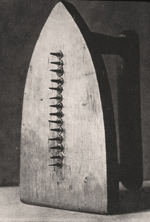 It is not hard to connect Man Ray with his early
family life; he was not the sort of artist who
disowns all his relatives. On the contrary, he
remained close to them in spite of living most of
the time on the other side of an ocean, or at
least a continent. Some of his work, like
"The Gift" (the famous flatiron with a row of
nails glued to its face) cannot but be read in the
light of his father's and mother's professions (he
was a tailor, she a seamstress). Likewise, fifty
or sixty years in advance of MoMA's discovery that
quilts can be high-class abstract art, he made a
quilt with cuttings from the floor of his
father's shop. Another of his objects overtly
conceals a sewing machine under ropes and a
blanket as if it were some kind of corpse to be
roughly disposed of. He called an exhibition
of a forest of linked coathangers "The Obstruction".
It is not hard to connect Man Ray with his early
family life; he was not the sort of artist who
disowns all his relatives. On the contrary, he
remained close to them in spite of living most of
the time on the other side of an ocean, or at
least a continent. Some of his work, like
"The Gift" (the famous flatiron with a row of
nails glued to its face) cannot but be read in the
light of his father's and mother's professions (he
was a tailor, she a seamstress). Likewise, fifty
or sixty years in advance of MoMA's discovery that
quilts can be high-class abstract art, he made a
quilt with cuttings from the floor of his
father's shop. Another of his objects overtly
conceals a sewing machine under ropes and a
blanket as if it were some kind of corpse to be
roughly disposed of. He called an exhibition
of a forest of linked coathangers "The Obstruction".
(The quilt is on view in this exhibition; its
appearance is rather rare due to its fragility.
You may not get another chance to see it soon.)
The exhibition itself, which might be considered a
standard Man Ray exhibition, in that it does not focus
on a particular aspect or period of his work or life,
contains these pieces and about 200 others, the
usual suspects or at least the usual categories.
Given that the world of great art
seems to still bear Man Ray something of a grudge*
-- there have been no major exhibitions of his
work in one of the big-ticket New York City
museums since 1974 -- this is a good
opportunity to see a lot of his work. While most of the
major categories of his work are represented, the
emphasis is on his photography, including a good
many rayographs.
(However, I suppose Man Ray himself
would disapprove, since he held photography to be
somehow a lesser art than painting, at least in
regard to his own artistic concerns. Or so he
said.)
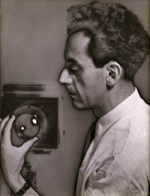 Besides the "straight" photographs and rayographs
there are several examples of
his experimental or surrealist photography,
including some of the solarizations.
(Either Man Ray or his companion of the era,
Lee Miller, invented
the solarization technique, and subsequently
Man Ray employed it regularly, especially in
portrait photography.)
Besides the "straight" photographs and rayographs
there are several examples of
his experimental or surrealist photography,
including some of the solarizations.
(Either Man Ray or his companion of the era,
Lee Miller, invented
the solarization technique, and subsequently
Man Ray employed it regularly, especially in
portrait photography.)
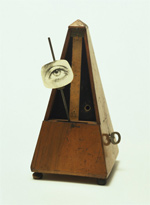 While Man Ray's photography predominates, the
exhibition also has several paintings, mostly
from the earlier part of his career,
drawings, prints, and, of course, the aforementioned
objects. Besides The Gift the exhibition
also has the famed
Indestructible Object, also known as
The Object To Be Destroyed.
The originals of both these objects have duly been
destroyed; these are copies made by Man Ray. They
have indeed proven indestructible.
While Man Ray's photography predominates, the
exhibition also has several paintings, mostly
from the earlier part of his career,
drawings, prints, and, of course, the aforementioned
objects. Besides The Gift the exhibition
also has the famed
Indestructible Object, also known as
The Object To Be Destroyed.
The originals of both these objects have duly been
destroyed; these are copies made by Man Ray. They
have indeed proven indestructible.
Besides works by Man Ray, there are a couple of
portraits of Man Ray by other artists; one by
Picasso is especially interesting, since Picasso
took the trouble to smudge the drawing, especially
the face, after excuting what was otherwise a
admirably lively ink sketch, helping his friend
stay hidden, or perhaps making fun of his desire
to do so.
So what about the deeper questions? Man Ray was
connected to his family, but they look from here
like pretty solid assimilationists. To further
connect Man Ray to Judaism, other than as one more
vigorous participant in artistic and literary
modernity of which the Jews supplied so many
prominent examples, requires the sort of involved
interpretive work we would get from the
psychoanalysts of yesteryear. This is where the
essays of Alias Man Ray, the book, come in.
(The argument is also made in more condensed form
on the Museum's web site.)
I will not try to summarize these arguments here,
which would hardly do them justice, and in any case
they require a certain belief in Interpretation
itself (contested territory!)
and a willingness to work one's way through the
arguments. Will an investigation of Man Ray's
Judaic roots broaden or narrow our understanding
of him? I imagine Man Ray's ghost shaking his
head and saying, "Don't tell them anything!" but
he's laughing as he says it.
Regardless of how you come out on those matters,
however, the exhibition itself is well worth seeing.
The Jewish Museum's bookstore has, besides the
book belonging to the exhibition, several others
from the Man Ray canon, although unfortunately
like many great books Self Portrait is out of
print and therefore not among them.
Two other reviews of the exhibition may be of interest:
"Man Ray: Name Dropping" by John Perreault (Artopia)
"Mercurial Jester, Revealing and Concealing" by Karen Rosenberg (N.Y.Times)
* Man Ray pretty much ignored or made light of
Abstract Expressionism at a time when it was
not only the dominant school of artistic
practice but a sort of religion as well. I
don't think this lèse majesté was
taken at all well by the critical establishment
of the era and perhaps, even now, has not yet
been forgiven.
|
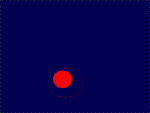
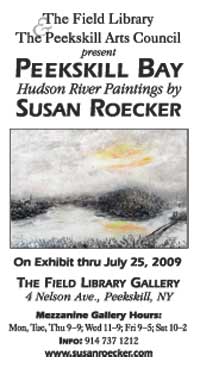



 It is not hard to connect Man Ray with his early
family life; he was not the sort of artist who
disowns all his relatives. On the contrary, he
remained close to them in spite of living most of
the time on the other side of an ocean, or at
least a continent. Some of his work, like
"The Gift" (the famous flatiron with a row of
nails glued to its face) cannot but be read in the
light of his father's and mother's professions (he
was a tailor, she a seamstress). Likewise, fifty
or sixty years in advance of MoMA's discovery that
quilts can be high-class abstract art, he made a
quilt with cuttings from the floor of his
father's shop. Another of his objects overtly
conceals a sewing machine under ropes and a
blanket as if it were some kind of corpse to be
roughly disposed of. He called an exhibition
of a forest of linked coathangers "The Obstruction".
It is not hard to connect Man Ray with his early
family life; he was not the sort of artist who
disowns all his relatives. On the contrary, he
remained close to them in spite of living most of
the time on the other side of an ocean, or at
least a continent. Some of his work, like
"The Gift" (the famous flatiron with a row of
nails glued to its face) cannot but be read in the
light of his father's and mother's professions (he
was a tailor, she a seamstress). Likewise, fifty
or sixty years in advance of MoMA's discovery that
quilts can be high-class abstract art, he made a
quilt with cuttings from the floor of his
father's shop. Another of his objects overtly
conceals a sewing machine under ropes and a
blanket as if it were some kind of corpse to be
roughly disposed of. He called an exhibition
of a forest of linked coathangers "The Obstruction".
 Besides the "straight" photographs and rayographs
there are several examples of
his experimental or surrealist photography,
including some of the solarizations.
(Either Man Ray or his companion of the era,
Besides the "straight" photographs and rayographs
there are several examples of
his experimental or surrealist photography,
including some of the solarizations.
(Either Man Ray or his companion of the era,
 While Man Ray's photography predominates, the
exhibition also has several paintings, mostly
from the earlier part of his career,
drawings, prints, and, of course, the aforementioned
objects. Besides The Gift the exhibition
also has the famed
Indestructible Object, also known as
The Object To Be Destroyed.
The originals of both these objects have duly been
destroyed; these are copies made by Man Ray. They
have indeed proven indestructible.
While Man Ray's photography predominates, the
exhibition also has several paintings, mostly
from the earlier part of his career,
drawings, prints, and, of course, the aforementioned
objects. Besides The Gift the exhibition
also has the famed
Indestructible Object, also known as
The Object To Be Destroyed.
The originals of both these objects have duly been
destroyed; these are copies made by Man Ray. They
have indeed proven indestructible.